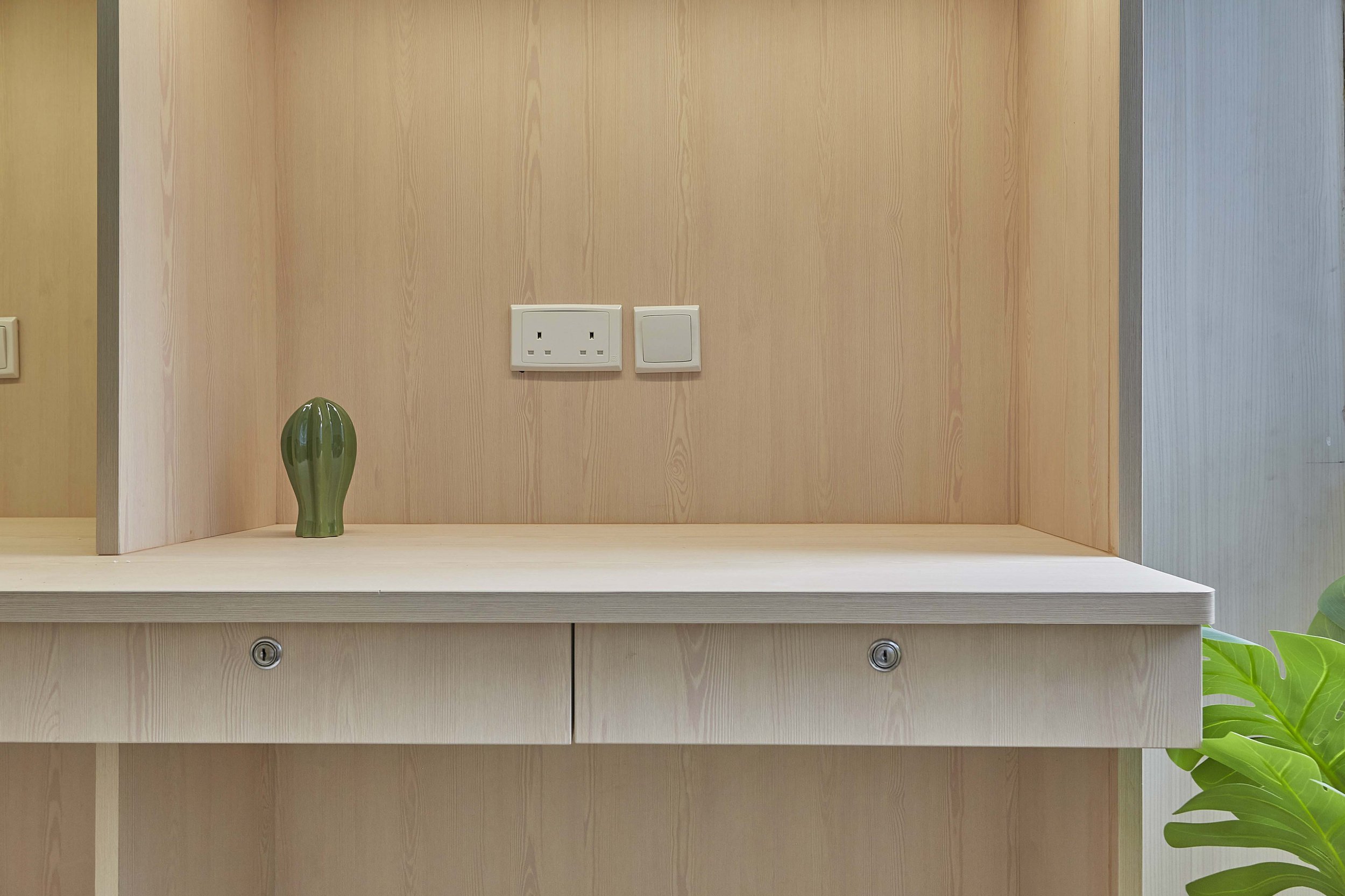Therapy Tree Home
樹 療 之 家
2500 sq.ft I Kowloon 九龍 I 2023
Therapy Space With Serene Elements Of Tree & Nature
樹影婆娑自然元素築建療癒心靈空間
With the continuous development and changes in society, many issues arise within primary families, sometimes temporarily separating children from their families. Some children may even have traumatic experience. In Hong Kong, there are non-governmental organizations (NGOs) dedicated to helping children grow by providing them with residential spaces that resemble a family environment. Social workers and house parents take care of their daily lives. However, as time passes and the number of children gradually increases, the existing spaces tend to be insufficient or under-utilised. Some residential facilities also begin to age, and the original designs rarely consider the specific needs of children. Therefore, there is a need for re-planning and design. In addition to expanding the existing functionality and spaces, can we consider more child-centered design ideas or elements from the perspective of their physical and mental well-being? In the existing residential floor plan, apart from centralized functionality, can we adopt different spatial strategies to better accommodate children with traumatic experiences? While redesigning the spaces, can we also take on more social responsibilities?
隨著社會的不斷轉變,往往衍生不少原生家庭問題,有時會令孩童暫時未能與家人生活,部分更甚可能經歷創傷經驗或事件。香港有非政府組織 (NGO) 熱心幫助孩童成長,為他們提供一個與家庭環境近似的住宿空間,並由社工及家舍家長等負責其起居日常等。但隨著歲月及宿童人數漸漸增長,原有的地方顯得不足或未能有效善用。部分住宿空間設施亦開始老化,原有的設計亦鮮有加入貼合孩童的設計考慮,因此有需要進行重新規劃及設計。但除了擴新原有的空間機能外,又是否能多考慮由孩童的身心靈角度出發,融入更宜居的空間構想或元素?在舊有的平面佈局上,除了集中功能分區外,又是否可有不同的空間策略,令具創傷經驗的宿童更能適應?在重新設計住宿空間的同時,我們又是否能肩負更多的社會責任?
Sim-Plex takes trees as its guiding principle. Trees are important natural elements that represent the existence of nature and the power of life. Natural environments help reduce stress and anxiety. With the concept of "Tree Therapy Home," this project not only brings the natural outdoor scenery of tree , lights and shadows into the interior but also incorporates designs that embody the tranquil atmosphere and abstract of trees, such as tree-shaped climbing ladders, storage stairs, pillars, and patterns, creating a coherent space for healing children's body and mind. In terms of spatial layout, to better integrate children with traumatic experiences, individual independent wardrobe and desk spaces are added to each bed in the shared residential space. These spaces not only serve as study areas but also provide a place for children to self-regulate and relax, like tree hollows. The design also incorporates curved corners and elements to ensure the safety of children. With modular storage units and different types of stairs and materials, the space is flexible and suitable for children of different ages.
Sim-Plex 以樹作引旨,樹木是重要的自然元素,代表著大自然的存在與生命的力量,自然的環境有助於降低壓力和焦慮。本案以「樹療之家」的概念,除將户外樹木光影的自然景致引借至內部,亦配合具樹木形象自然寧靜氛圍的設計,如樹型的爬梯、收納梯、立柱或圖案等,連貫建構出療癒孩童身心靈的空間;在空間佈局上,為令具創傷經驗的宿童更能融入,有別以往全部功能集中放置,在共融住宿空間中的每格床位加入了各自的個人獨立衣櫃及書桌空間,作溫習功課用之餘,亦可如樹洞般給孩童作自我調節;在設計上亦融入圓弧的語彙,照顧到孩童的安全性;以組合型的收納傢倶及不同類別的扶梯、物料等,彈性適合不同年齡的宿童。
Based on the curved safety design and flexible modular storage functionality, this project creates a layout where the natural and design elements of tree, lights and shadows coexist, forming a healing and therapy space for children's minds of different ages and backgrounds.
本案在圓弧安全設計及彈性組合型收納機能下,以樹影婆娑的自然與設計元素、共融獨立並存的佈局締造出可療癒具不同年齡層面及背景的孩童心靈住宿空間。
Coexistence Of Inclusion & Independent Self-Relaxation Areas
In a children's home, some residents have experienced issues within their primary families and even have traumatic experiences, so extra caution is needed in terms of space. In the overall layout, the principle of separating male and female residents is still followed. Each dormitory can accommodate four people, abandoning the previous practice of centralized functionality, such as bunk beds and rows of desks, which not only obstructed the view of trees and natural light from the windows but also provided very little floor space for activities, without considering individual independent areas. Children with traumatic experiences not only need the care of house parents and guidance from social workers but also require personal independent areas for self-regulation and relaxation.
共融與獨立自我調節區域的並存
在孩童之家中,有部分宿童經歷原生家庭的問題,甚至具有創傷經歷,所以在空間上需更為注意小心。在大佈局上,仍採取男宿女宿分開的原則,一間宿房可共住四人,摒棄原先功能集中的做法,即舊時上下格床及連排書桌的佈局,因不僅阻礙窗外的樹木景致及自然光,地面活動空間也甚少,更沒有個人獨立區域的考慮;具創傷經歷的孩童除了需要家舍家長的照顧及社工的輔導外,更重要是他們需要個人獨立區域自我調節放鬆。
Therefore, in the planning process, all beds are raised, and the bed surrounding backpane have openings to facilitate the care of house parents while reducing the sense of confinement. The lower level is supported and divided by storage wardrobes, allowing each bed to have a corresponding independent wardrobe and space for flexible placement of purchased desks. The wardrobe sides also incorporate bookshelves and drawers for the convenience of children to study in their independent areas on the lower level. Warm white lights are installed, which can be turned on when children are studying. In this independent desk space, residents can also engage in self-regulation and relaxation of their minds, resembling the healing effect of a tree hollow.
於是在規劃上把所有床位升高,床圍板有透空位,方便家舍家長照顧孩童,亦減少局促感;下層則以收納衣櫃作支撐及分隔,令每床位在下層也有相應獨立的衣櫃及空間彈性放置外購書桌,衣櫃側身亦融入了書櫃及抽屜的設計,方便孩童在下層的獨立區域溫習,亦設置滲燈暖白光,孩童溫習時可打開,而在這獨立的書桌空間,宿童亦可作自我的心靈調節,仿如樹洞療癒般的作用。
Curved & Natural Design Elements For Children's Safety
Children often move around in living spaces, and if there are sharp corners, they are prone to accidents and injuries. Therefore, this project incorporates curved corner designs and elements inspired by trees and nature. The upper-level beds are shaped with large curved corners along the circulation pathways to avoid collisions. The materials are arranged in alternating patterns of maple, ash oak, and white oak formica boards, resembling the natural textures of wood. Some beds also incorporate natural elements in the form of hill-shaped designs. The columns, climbing ladder and storage staircase supporting the upper-level beds are shaped like streamlined narrow leaves at the top and widening towards the bottom, while the handrails of the ladders have hollow spaces and curved corners to prevent injuries and allow natural light to penetrate.
以圓弧自然設計語彙融入孩童安全考量
在住宿空間中孩童常常往來走動,若有較多的尖角位,便會甚易會撞到受傷。本案於是融入圓弧造型,並配以自然樹木形而上的設計語彙:上層床位在活動通道的部分全以大圓弧角塑造,避免碰撞,並分成两層裝飾物料以楓木、灰橡木及白橡木紋美耐板交錯使用,亦在部分床位加入山丘造型的自然元素;支撐上層床的立柱、爬梯或收納梯均以流線樹葉上窄下闊作為型態,而梯的扶手有中空位及弧角,避免𠝹傷手亦不阻礙自然光的滲透。
In the arrangement of the living room, features such as sofa and dining seats are paired with movable coffee tables, which also incorporate curved designs to prevent collisions. Different colored wood grain materials are used on different floors, and some include nature-inspired patterns such as trees and hills to prevent the space from feeling dull and to enhance the natural atmosphere. The room of house parents and social works was planned with a centralised working desk and book shelves for their discussion of work.
在客廳佈置中,梳化座位及餐座等,配以可移式茶几桌,亦加入了圓弧的造型,避免撞傷,在不同樓層亦有不同的顏色木紋物料配搭,部分亦加入了自然元素圖案如樹木、山丘等,令空間不覺沉悶及增添大自然氛圍;家舍家長及社工的工作室則以集中工作枱面書架作佈局,方便他們工作討論等。
Multiple Modular Furniture & Flexible Stairs For Children Of Different Ages
In the children's home, apart from the distinction between boys and girls, there is also a wide age range from four to eighteen years old. This includes younger children as well as older youth. The existing dormitories were all designed with the same furniture, which posed inconvenience and safety concerns for younger children using the stairs. In the redesign process, flexibility for accommodating children of different ages and genders was taken into consideration: For children aged four to eleven, storage stairs with handrails are provided, positioned between two beds. This ensures safety and convenience for younger children who are smaller in body size. For youth aged twelve to eighteen, climbing ladders are provided, as they are taller and more capable of using them easily. The design of the lower section of the steps is deeper, making it convenient for going up and down, and handrails are also provided for safety. The furniture combinations are adjusted according to different floors and positions. The upper bunk beds are sometimes arranged horizontally in a row and other times arranged vertically side by side. The principle is to avoid obstructing natural light near the windows, and the back panels of the beds also have partial openings to allow light to pass through. There are also material distinctions between boys' and girls' dormitories. Boys' dormitories use materials with heavier textures such as white oak and maple, while girls' dormitories are furnished with lighter and cooler materials such as pure white and ash oak. The storage wardrobes inside are also equipped with grey-blue and pink formica boards for boys and girls, respectively.
多元組合型收納與扶梯彈性貼合不同年歲宿童
在孩童之家中除男女有別之外,年齡亦有不同範圍由四至十八歲不等,所以當中包括年紀較小的小孩,亦有較大的青年,舊有的宿房全部配以同一款的傢倶設計,有些年紀較小的孩童使用爬梯會不便,甚至有安全隱憂。本案在重新設計時融入了彈性貼合不同年齡性別宿童的考慮:給四至十一歲小孩童的,會配以收納樓梯及扶手,其位置在两床位中間,孩童身形偏小,所以上落時也較為安全及方便; 給十二至十八歲青年的,則配以爬梯,青年身形偏高大有力,用爬梯會較易,而且梯級下段造型較為深長方便上落,亦配以扶手顧及其安全; 傢俬組合按不同樓層及位置調整,上格床有時是橫向一排,有時則是直向並排,在靠窗位置以盡量不阻礙自然光為原則,支撐背板亦會局部偷空透光;男女宿亦有物料上的區分,男宿以白橡及楓木等較重紋路的物料,女宿則配以淨白及灰橡等輕冷的物料,收納衣櫃內籠亦各配以灰藍色及粉色美耐板給男女宿。
The material selection follows the principles of children's health and sustainability. Fire-resistant and E0 grade formica boards are used, which are also more resistant to wear and tear. Plywood and fabric cotton are also verified to be flame retardant. The combination of bed sets and storage cabinets is designed for flexible installation, allowing for disassembly and reassembly in another location if necessary, promoting reusability and sustainability.
物料上的選用盡量以兒童健康及可持續性為原則: 選用防火及E0甲醛含量的美耐板面料,亦比較防花耐用,細蕊夾板及布料棉亦採用具阻燃驗證的;組合型的床架、收納櫃等,均全以彈性組裝方便日後若有需要可拆走及改至另一地方組裝,具重用及可持續性。
This project “Therapy Tree Home" not only incorporates curved safety designs, multiple storage functions, and natural tree elements, but also aims to create a space layout that embodies both inclusiveness and independence, providing a healing accommodation environment for children of different ages and backgrounds.
本案「樹療之家」通過采用圓弧安全設計和彈性組合型收納功能,以自然的樹影和設計元素為特色,創造出其共融與獨立並存的空間佈局,旨在提供具治癒性的、適合不同年齡和背景的兒童心靈住宿空間。























































































